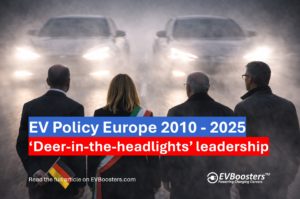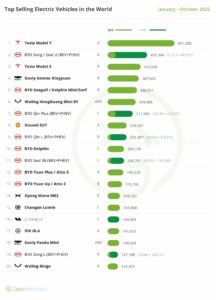The rise of Electric Vehicles in Belgium
Belgium, like much of Europe, is seeing a strong shift towards electric mobility. This change is influenced by the European Union’s plan to ban petrol and diesel car sales by 2035 and the wider push to cut carbon emissions from road transport, which accounts for a significant share of the EU’s CO2 output.
EV adoption in Belgium is rising quickly. As of 2024, battery electric vehicles (BEVs) make up 3,2% of the country’s total fleet, with new registrations surging from 10% in 2022 to 25% in 2024. This growing demand for EVs is putting pressure on the country’s charging infrastructure, which has had to scale up rapidly to keep pace.
A surge in public charging points
By the third quarter of 2024, Belgium had 77.443 publicly accessible charging points—a staggering 72% increase from the previous year. This expansion reflects the urgency of providing sufficient charging options for the country’s rising number of EV drivers.
A significant aspect of this growth is the rapid deployment of ultra-fast charging stations. These stations, which deliver 100 kW or more, are ideal for drivers looking for quick charging options on longer journeys. In just 12 months, the number of ultra-fast chargers in Belgium has grown by an impressive 119%, underscoring the growing importance of fast charging infrastructure.
How ultra-fast charging has evolved
Ultra-fast charging has seen a dramatic rise in Belgium, especially over the past two years. As of 2024, there are 3.162 fast chargers installed across the country—an increase of nearly 119% in just one year. These chargers now account for 30% of the total power available from public EV charging points in Belgium, highlighting the critical role they play in meeting the needs of modern EV drivers.
Though Belgium’s growth is impressive, it slightly lags behind countries like France, which experienced a six-fold increase in ultra-fast charging infrastructure over the same period. Nevertheless, Belgium’s five-fold increase still represents significant progress, showing the country’s commitment to building a robust charging network.
Key players driving the expansion
The rapid growth of Belgium’s ultra-fast charging network is being driven by an increasingly competitive market. In the past year, the number of charge point operators (CPOs) offering fast charging has doubled, rising from 30 in 2023 to 60 in 2024. However, despite this increased competition, five major players—Allego, IONITY, Tesla, Shell, and TotalEnergies—still control about half of the country’s fast charging points.
Local companies are also making their mark in this expanding market. Players like Sparki, Powerland, Optiload, and Smappee are gaining ground, with Sparki standing out for its exclusive focus on ultra-fast charging stations delivering 300 kW or more. Another standout is Electra, a company that entered the Belgian market in 2023 and quickly became a major player by offering a large number of charging points with high power capacity.
Technology meets user experience
While the availability of ultra-fast charging stations is crucial, the actual charging speed depends largely on the vehicle’s ability to handle high power levels. Many newer EV models are designed to take advantage of ultra-fast charging, allowing drivers to significantly reduce charging times on long trips. This capability makes these stations particularly valuable for EV drivers who need to charge quickly on the go.
Challenges in utilisation and future opportunities
One challenge Belgium faces is the relatively low utilisation rate of its DC fast chargers, which typically see only 7-8% use. On average, this means fewer than two charging sessions per day per station. This low usage can be attributed to several factors, including the higher cost of DC charging and the fact that it’s mainly used for longer trips, whereas slower AC chargers are more commonly used for everyday charging in retail or parking locations.
Despite these lower rates, both AC and DC charging usage have been gradually increasing, reflecting the growing number of EV drivers. As more people switch to electric vehicles, the demand for all types of charging infrastructure, including ultra-fast charging, is likely to rise.
The road ahead for ultra-fast charging in Belgium
As Belgium pushes toward its climate goals and EV adoption continues to grow, the expansion of ultra-fast charging infrastructure is expected to accelerate. While the market is becoming more fragmented with the entry of new players, a few major operators still dominate the fast charging landscape. This competition is likely to drive further innovation, with CPOs striving to improve not only the speed but also the reliability and user experience of their networks.
Belgium’s charging market will also benefit from advances in EV battery technology, which will allow cars to charge faster and travel longer distances on a single charge. These developments will make long-distance travel in EVs more convenient, helping to address one of the key barriers to wider EV adoption.
Conclusion
In conclusion, the ultra-fast charging network in Belgium has seen remarkable growth over the past few years, driven by the country’s rapid adoption of electric vehicles. While there are still challenges—such as low utilization rates for fast chargers—continued expansion and technological advancements will help Belgium build a more robust and efficient charging infrastructure.
As competition in the market heats up, service quality and user experience will become critical factors for success, with CPOs striving to meet the evolving needs of EV drivers. Looking ahead, Belgium’s commitment to developing its ultra-fast charging network will be vital in supporting the country’s transition to a greener, more sustainable future.
Source: Gireve







